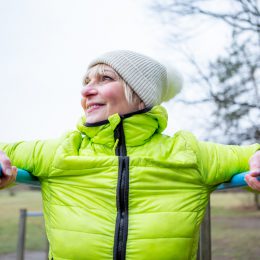Find Your Place: The Parkinson’s Screen
This quick test can help you spot a tremor and early signs of a movement disorder.
Can you balance a piece of paper on your outstretched hands? After a few seconds, does the paper shake or fall to the floor? In this video, SilverSneakers fitness expert David Jack shows how this quick test can give you clues about tremor and movement disorders like Parkinson’s disease.
You’ll need a piece of paper, which makes it easier to see any movement in your hands. Try the test now, then see what your results mean below. If you have Parkinson’s or a condition that affects movement, skip the test, but check out the tips below.
If the Paper Was Still on Both Hands
That’s a sign there wasn’t any trembling or shaking in your outstretched arms after a period of time, which is one type of tremor associated with Parkinson’s.
Another quick check: Do you notice any trembling or shaking anywhere in your body in daily life? If so, as with any change in your health, it’s a good idea to talk to your doctor sooner rather than later.
Generally feel fine and don’t notice any changes in your health? It’s still a good idea to check in with your doctor at least once a year. What else you can do: Stay active to keep your body and brain in good health. Get inspired with workouts for all fitness levels on the SilverSneakers GO app (free, iOS and Android).
If the Paper Shook or Fell to the Floor
That’s a sign there was trembling or shaking in your outstretched arms after a period of time. This may be one type of tremor associated with Parkinson’s, a disorder that affects an area of the brain that controls balance and movement. Another, more common type of tremor seen with Parkinson’s: tremor that affects the hands when they’re at rest, such as in your lap.
That’s also a sign to talk to your doctor. There are more than 20 types of tremor, and they can occur in different parts of the body, according to the National Institute of Neurological Disorders and Stroke. Tremor by itself isn’t life-threatening—but it can make everyday activities difficult, and it can be a symptom of an underlying health issue that needs to be addressed.
Your doctor can determine if there’s an issue, what it is, and the best next steps. To make a conversation easier, let your doctor know any:
Subscribe to our newsletter
It's quick and easy. You could be one of the 13 million people who are eligible.
Already a member? Click to discover our 15,000+ participating locations.
Follow Us
- Conditions you have or if you’ve had any medical events like a stroke or serious injuries
- Medications you take, including prescriptions, over-the-counter drugs, and supplements
- Symptoms you’ve noticed, including any of these early warning signs of Parkinson’s
If You Have Parkinson’s Disease or a Condition That Affects Movement
Worried that you shouldn’t exercise if you have a condition that affects your nervous system and movement, like Parkinson’s ? It turns out, staying active can help improve coordination, balance, and cognition—and it may even slow the progression of the condition. Check out these six rules for exercising with Parkinson’s.
If you have had a medical event like a stroke or serious injury, you’ll want to work closely with your health care team for a safe recovery. Your timeline and specific steps of recovery will depend on what you experienced, but primary goals are the same: to regain function and resume activity as much as possible. Ask these questions:
- Do I need additional medical treatment or physical therapy?
- When can I start exercising on my own again?
- What types of exercise are appropriate for me, and what types should I avoid?
- Is there anything else I can do to help myself with recovery? For example, your doctor may recommend taking good care of your emotional heath. Depression, which is common after serious medical events, can slow down recovery—but it’s treatable.
Check Your SilverSneakers Eligibility Instantly
SilverSneakers gives you free, unlimited access to more than 15,000 gyms and fitness centers across the nation, plus classes and tools designed to keep older adults strong and independent. Check your eligibility instantly here. Already a member? Get your SilverSneakers member ID and exclusive content by logging in to or creating your online account here.





